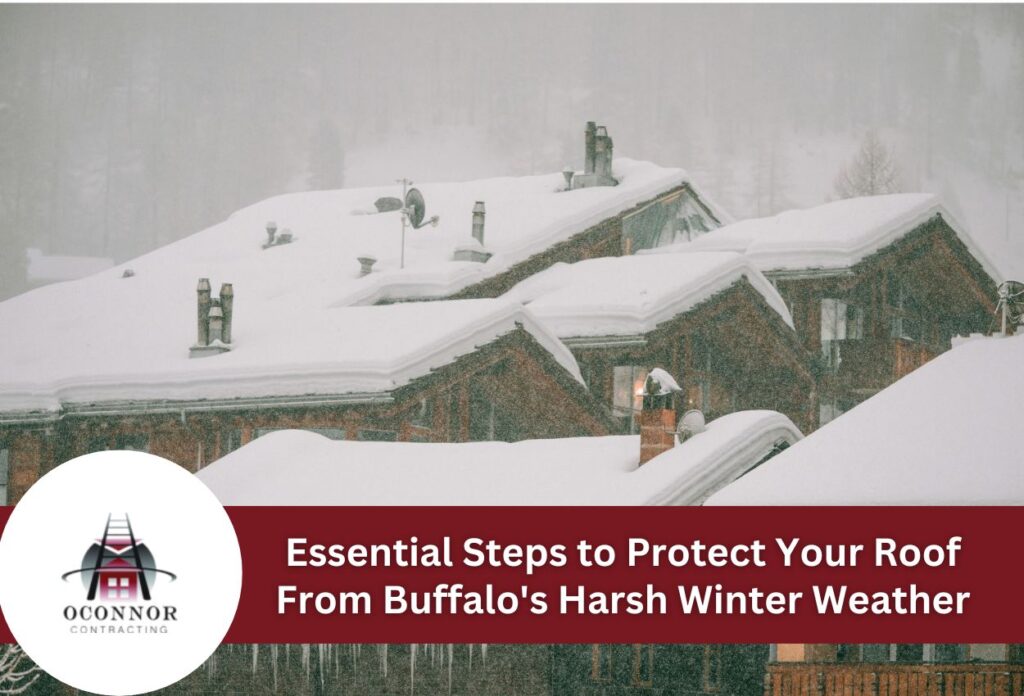Essential Steps to Protect Your Roof From Buffalo’s Harsh Winter Weather

Buffalo winters bring some of the most challenging weather conditions roofs face throughout the year. Heavy snowfall, ice formation, and freezing temperatures create the perfect conditions for roof damage that can lead to expensive repairs and compromises to the safety of your home.
Roof winter preparation involves more than simply hoping your roof survives until spring. Ice dams form when warm air melts snow on the roof, which then refreezes at the edges, creating barriers that force water under shingles. Protecting against snow weight becomes essential as accumulated snow can exceed the structural limits of older roofs, with these problems developing quickly during Buffalo’s notorious lake-effect snowstorms.
Effective winter roof maintenance focuses on addressing vulnerabilities before cold weather arrives. Roof insulation helps maintain consistent temperatures that prevent the freeze-thaw cycles responsible for ice dam formation. Proper attic ventilation works alongside insulation to create balanced airflow that keeps roof surfaces at stable temperatures. Cleaning gutters and downspouts ensures proper drainage when snow begins melting during warmer periods.
Clearing and Cleaning Your Gutters and Downspouts Before Winter Hits
Proper gutter maintenance represents one of the most important ways to winterize your roof effectively. Clogged gutters filled with leaves, twigs, and debris create dangerous conditions that lead directly to problems like ice dam formation and backed up water. When gutters cannot channel melting snow and ice away from the roof’s edge, water accumulates and refreezes repeatedly, forming thick ice barriers that force moisture under shingles.
To prevent this, remove all debris from gutters using a sturdy ladder and proper safety equipment, and pay special attention to downspout connections where leaves commonly create blockages. Flush the entire gutter system with water to identify any remaining clogs or drainage issues, then check that all gutters maintain proper slope toward downspouts to ensure efficient water flow during winter roof maintenance periods.
Installing quality gutter guards provides long-term protection against debris accumulation while reducing maintenance requirements. These protective systems allow water to flow freely while keeping out leaves and larger debris that cause blockages. Properly functioning gutters prevent ice dams by maintaining consistent drainage patterns that eliminate standing water.
Sealing Air Leaks and Checking Your Attic Insulation
Air leaks in attic spaces create the temperature imbalances responsible for ice dam formation along roof edges. Warm air escaping through gaps around recessed lights, electrical outlets, plumbing vents, and attic access points heats the roof surface unevenly. This heated air melts snow directly above these leak points while leaving other areas of the roof cold, creating the perfect conditions for ice dams to develop.
Common locations where air leaks form include where different building materials meet such as where interior walls connect to attic floors. Gaps around chimneys, exhaust fan housings, and cable or wire entry points also allow significant amounts of air to escape. These seemingly small openings collectively contribute to major temperature variations across the roof’s surface during periods of winter roof maintenance.
Proper amounts of insulation help maintain consistent roof temperatures that prevent ice dam formation. Attic insulation should meet current building codes, typically requiring R-values of R30 to R60 depending on climate zone requirements. Insufficient insulation allows heat transfer that warms roof surfaces, while excessive insulation without proper ventilation can trap moisture and create different problems.
Balanced attic ventilation works alongside insulation to maintain stable roof temperatures. Installing soffit vents for air intake and ridge or gable vents for exhaust creates continuous airflow that prevents heat buildup. This combination helps protect against ice dam formation while supporting effective ways to winterize your roof.
Inspecting and Repairing Shingles and Roof Materials
Damaged or loose shingles create direct pathways for water to get in during winter storms when snow and ice accumulate on the roof’s surface. Even small gaps between shingles allow moisture in that leads to interior damage and structural problems. Missing granules, cracked surfaces, or lifted edges expose underlying materials to harsh weather conditions that accelerate deterioration throughout the winter.
Examine each shingle for signs of wear, including curling edges, bare spots where granules have worn away, or areas where wind has pried the material loose. Pay close attention to valleys as well, where melted water naturally channels down during periods of snow melt. These high-traffic areas experience increased wear and often develop problems first. Replace any damaged shingles immediately to prevent water from getting in during freeze-thaw cycles that plague winter roof maintenance periods.
Flashing around chimneys, vent gaps, and roof intersections requires careful inspection before freezing temperatures arrive. These metal barriers direct water away from vulnerable joints where different materials meet. Check that all flashing remains securely fastened and properly sealed against gaps and apply appropriate sealants to any gaps or loose connections found during inspection. Loose or damaged flashing allows water to seep beneath roofing materials where it can freeze and expand, creating larger gaps that get worse with each freeze-thaw cycle.
These winter preparation steps prevent ice dams from forming around penetrations while protecting structural elements from moisture damage that develops when snow load protection fails during heavy accumulation periods.
Understanding and Preventing Ice Dam Formation
Ice dams develop when heat escapes through the roof, melting snow that refreezes at the roof’s edge where temperatures remain below freezing. This cycle creates thick ice barriers that prevent proper drainage and force water beneath shingles, leading to interior leaks, damaged insulation, and rotted roof decking. The weight of accumulated ice can also damage gutters and cause them to pull away from the roofline.
The formation process begins when warm attic air heats the roof surface unevenly. Snow melts on the warmer upper sections of the roof, then flows down toward the colder eaves where it refreezes. Each melting and refreezing cycle adds more ice to the dam, creating larger barriers that trap increasing amounts of water. This trapped water eventually finds its way under shingles and into the home’s interior structure.
Heat cables offer an effective solution for preventing ice dam formation along roof edges and in gutters. These electric heating elements maintain consistent temperatures that prevent ice accumulation in critical drainage areas. Install heat cables in zigzag patterns along roof edges and extend them into gutters and downspouts to maintain clear water pathways throughout the winter.
Preparing Your Roof to Handle Heavy Snow
Snow accumulation poses serious structural risks that require careful monitoring throughout the winter. Most residential roofs can safely support 20 to 25 pounds per square foot of snow, but this capacity varies significantly based on roof age, design, and construction materials. Fresh powder snow weighs approximately 5 to 10 pounds per cubic foot, while wet, compact snow can reach 15 to 20 pounds per cubic foot. Ice adds even more weight, creating dangerous conditions that exceed design limits.
Recognizing the warning signs of excessive weight caused by snow becomes important for preventing structural damage. Interior signs include cracking sounds from the roof structure, doors, and windows that suddenly stick or become difficult to operate, and visible sagging in ceiling areas. Exterior warning signs include bent or damaged gutters, visible roof sagging when viewed from ground level, and cracks appearing in exterior walls near the roofline.
Safe snow removal requires proper equipment and techniques that protect both the roof surface and personal safety. Use plastic shovels or specialized roof rakes designed for snow removal to avoid damaging shingles. Remove snow in sections rather than attempting to clear entire areas of the roof at once, which creates unbalanced conditions and leads to potential damage. Work from the ground whenever possible as well, using extension tools rather than climbing onto icy roof surfaces.
Professional snow removal services become necessary when the amount that’s accumulated exceeds safe limits or when ice formations make DIY removal dangerous. These specialists understand the proper protection techniques and have equipment designed for safe roof access during hazardous winter conditions.
Professional Maintenance Tasks Worth Considering This Fall
While homeowners can handle many basic winter roof preparation tasks, certain maintenance activities require professional expertise to ensure thorough protection and safety. Professional roofing contractors possess the specialized equipment, training, and experience necessary to identify potential problems that untrained eyes often miss. These experts understand the specific challenges that winter weather creates and can implement the right solutions to address both obvious issues and underlying vulnerabilities that could develop into expensive problems.
Roof inspections conducted by qualified professionals reveal structural concerns, ventilation problems, and material deterioration that may not be visible from ground level. Contractors can safely access steep roof areas, examine flashing details around gaps, and assess the condition of materials in valleys and other critical areas. They also evaluate attic insulation levels, ventilation patterns, and identify sources of air leaks that contribute to ice dam formation during the winter.
Complex repairs involving structural elements, extensive flashing work, or major material replacement, exceed the capabilities of typical homeowners. Professional installation of ventilation systems, insulation upgrades, or shingle replacement requires specialized knowledge to ensure proper integration with existing roofing materials and features. These contractors understand local building codes and weather patterns that influence effective ways to winterize your roof.
Protect Your Home with OConnor Contracting and Get Expert Winter Roof Preparation in Buffalo
As Buffalo’s winter approaches, ensuring your roof is prepared to handle the harsh conditions is important. At OConnor Contracting, we specialize in roof winterization to protect your home from heavy snow, ice, and freezing temperatures that can lead to expensive damage. Don’t wait for the first snowfall to find out your roof isn’t ready.
Call us today at (716) 600-7663 to schedule your roof’s winter preparation service with OConnor Contracting and enjoy peace of mind throughout the season.



